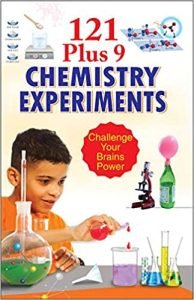Endothermic Cold Wave (Chemistry Experiments)
If a chemical change can cause heat (exothermic), can another chemical change make something cold?Things Required:A thermometer1 tablespoonful of Epsom saltsTap water, neither hot nor coldSpoonA medium-size jarPencil and paperDirections:Fill the jar with tap water. Place the thermometer in the water. With your hand, feel the coolness of the jar while you wait until the […]

 121 Plus 9 Chemistry Experiments for kids is an excellent book to teach the subject with cool experiments. Read with your kids and help them understand the chemistry behind various things.
121 Plus 9 Chemistry Experiments for kids is an excellent book to teach the subject with cool experiments. Read with your kids and help them understand the chemistry behind various things.